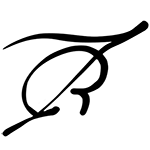

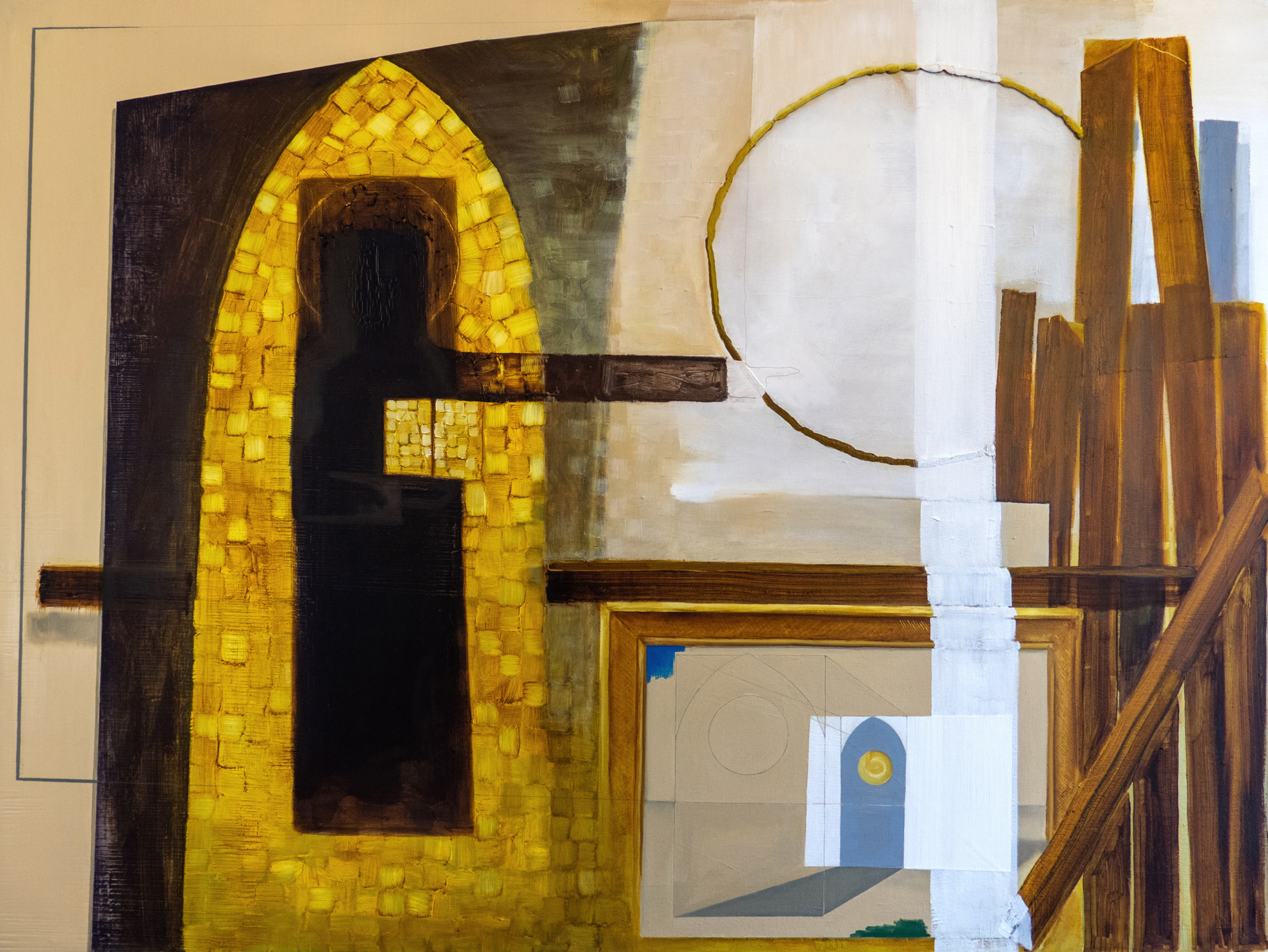
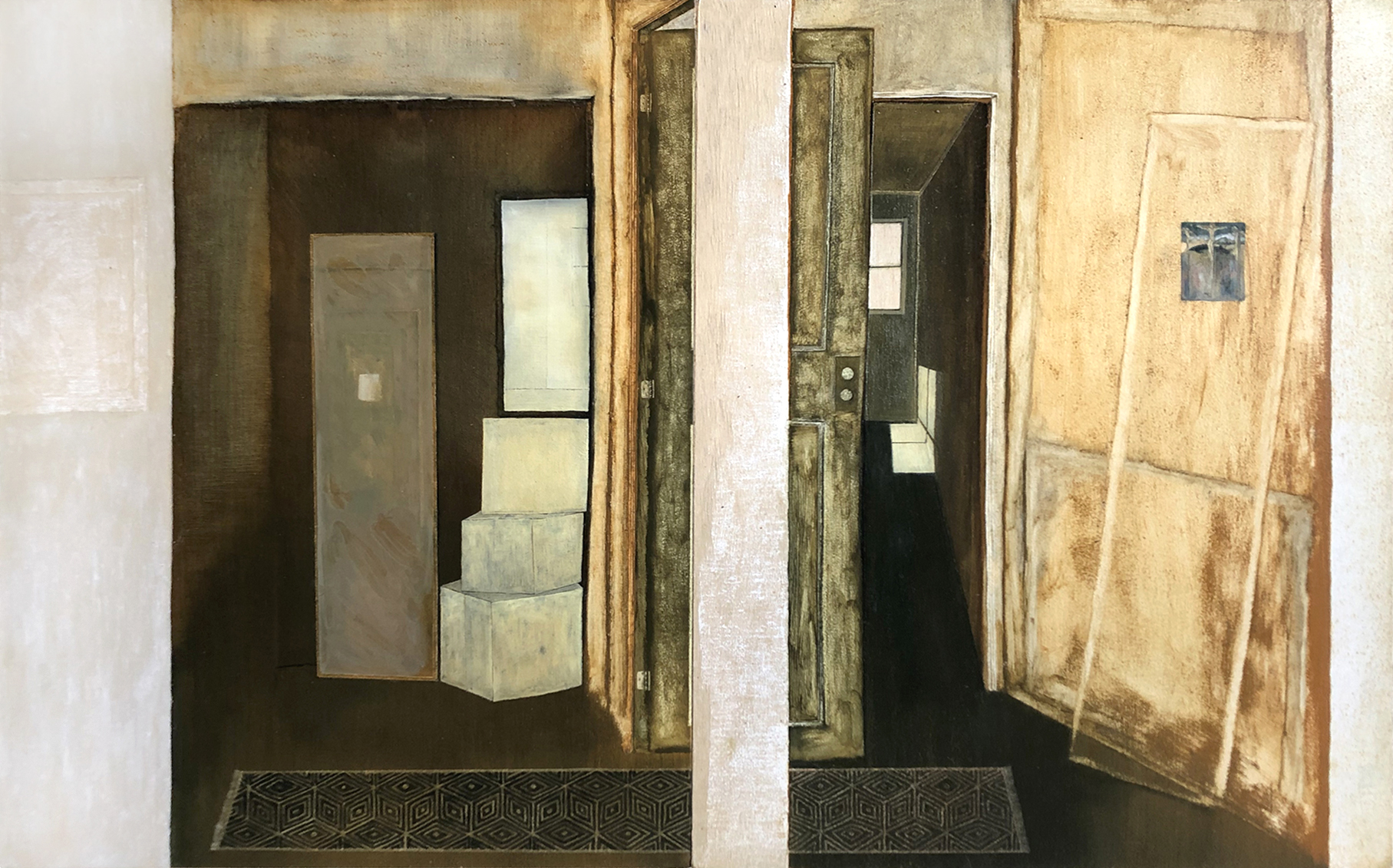

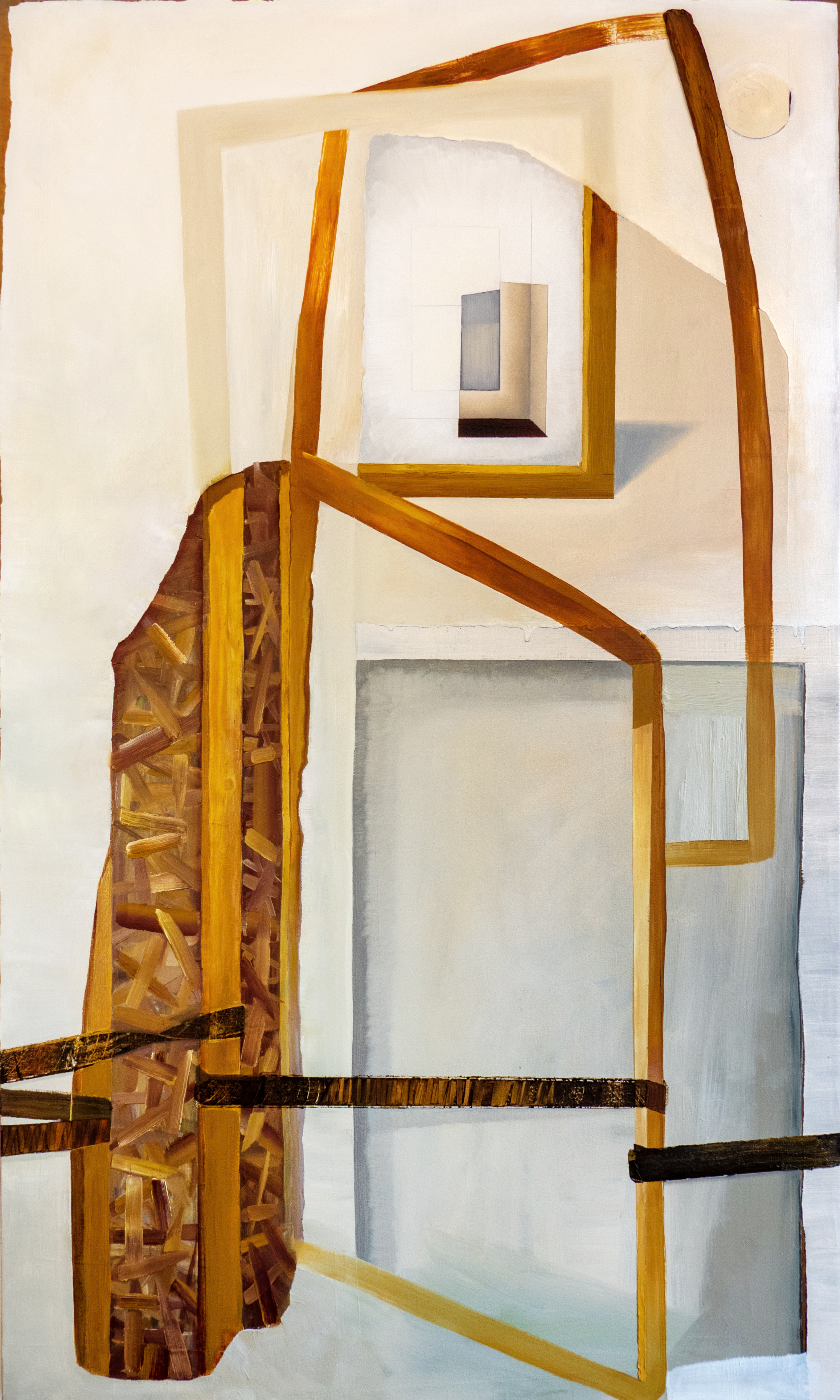
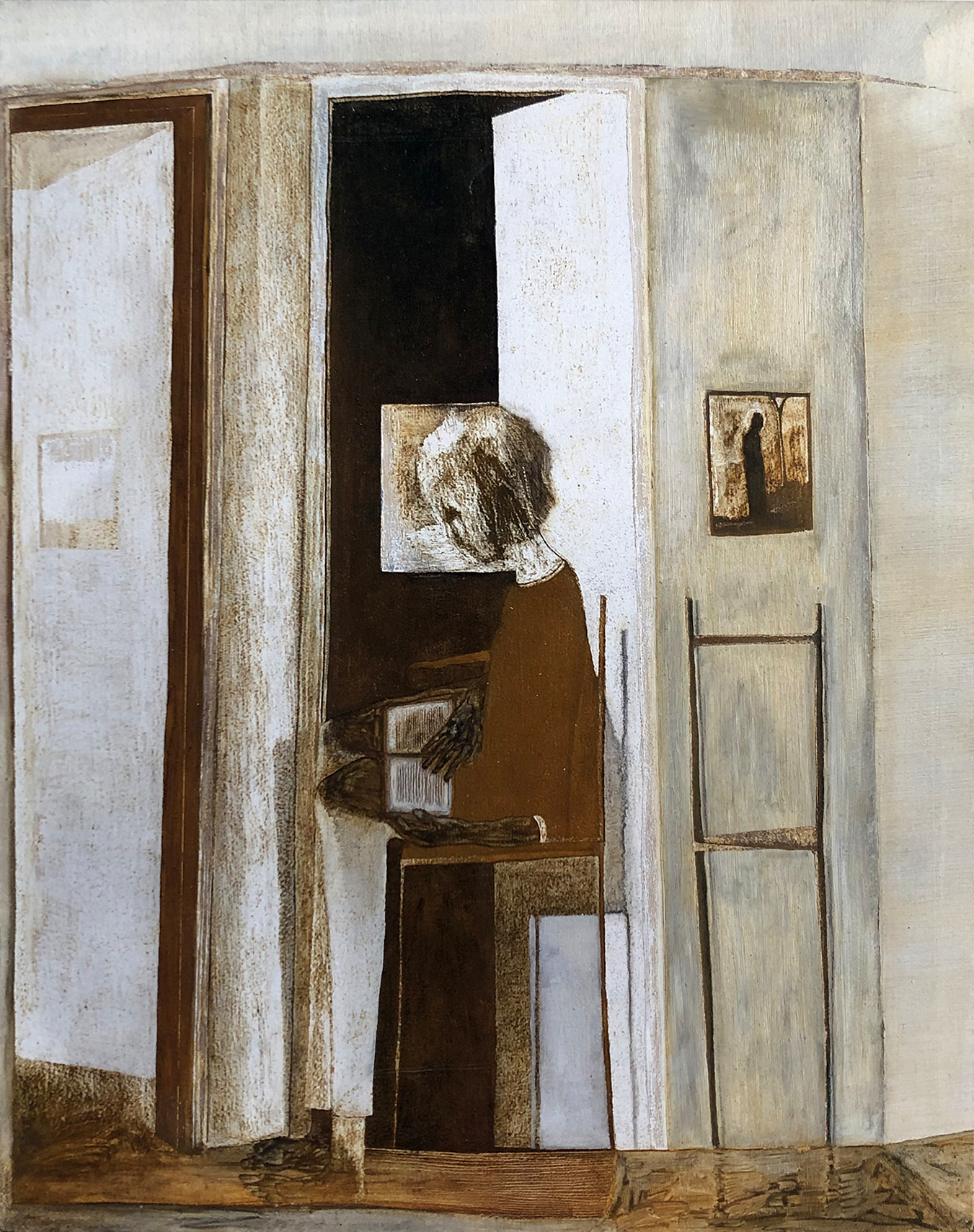


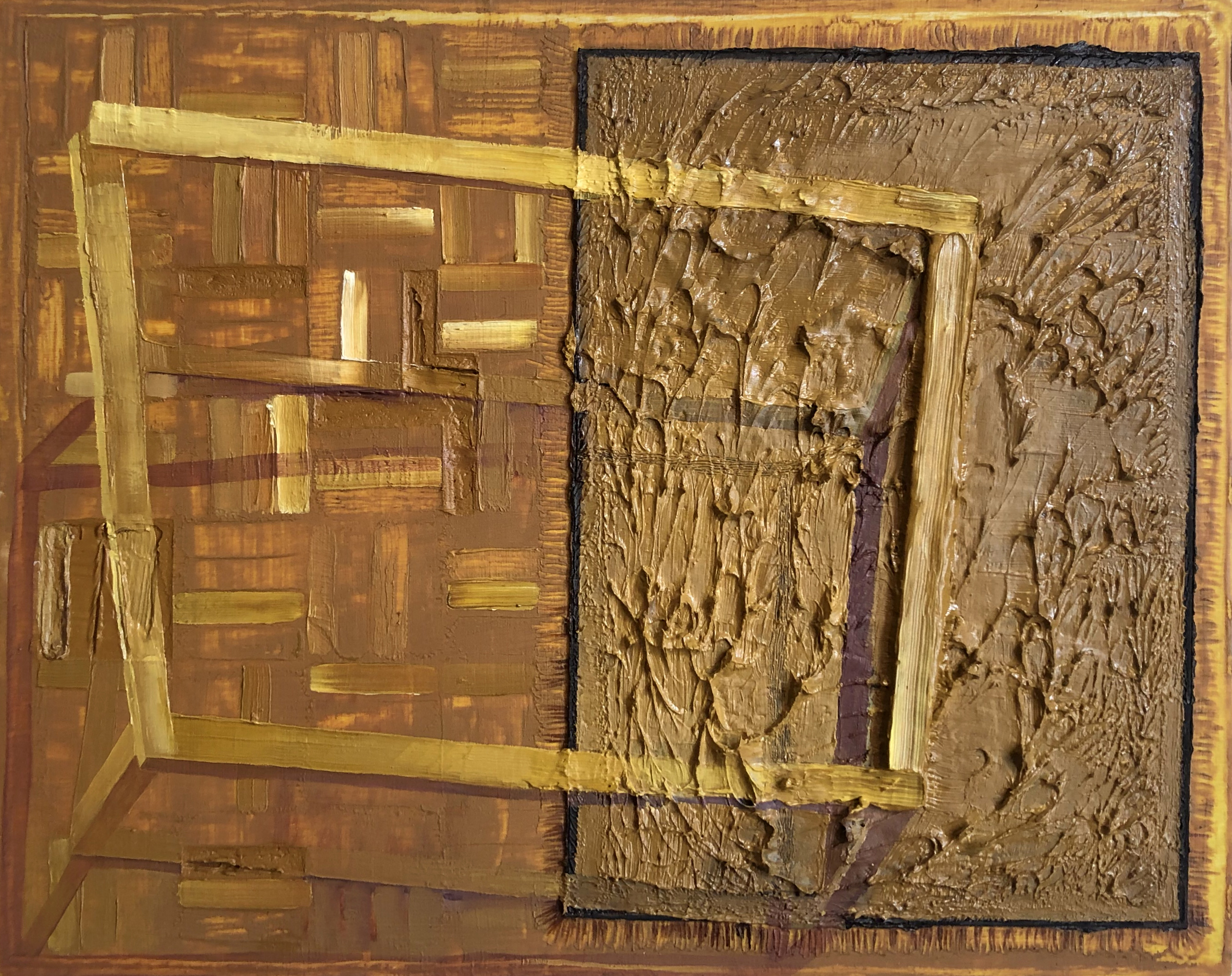




Let's begin with a blank canvas, oriented horizontally.
A horizontal canvas implies a horizon line; a horizon line, a vanishing point; and soon, by means of naturalistic painting techniques developed to mimic the optical perception of space, the flat surface of the canvas advances and recedes, producing space, or the illusion of it. The painting appears to be a window, its edges the window jambs, its painted surface the pane of glass through which vision can penetrate, traverse distance, possess the horizon and all that lies between. A naturalistic painting, which is really a paint film on an opaque surface, embodies a world in which there are two levels—appearance and reality. To understand reality we must get beneath the surface, so, beginning with what appears, we reason backwards to its originating cause. Were we looking out a real window at the surrounding environment, we would discover, through observation and experimentation, that it is produced by natural forces not apparent to the eye (laws of gravitation, motion, thermodynamics, etc.). We are, in this world, animals in an environment, subject to these natural forces, trying to survive and reproduce—intelligent animals who, motivated to explore, invent and conquer, strive to not merely subsist but flourish. We desire to understand natural laws so we can intervene in the causal chain that produces an environment unfit for human life, in hopes of satisfying our basic needs for space, food and shelter. The land is something to be dominated and domesticated; developed to our advantage, then to our pleasure. A painting of a landscape has a different causal history than an actual landscape—the product not of natural laws merely but of a human who has learned the laws that govern the nature of their artistic material (pigment, oil, acrylic polymers, etc.), who has studied the optical effects of the world they inhabit and arrived at techniques for reproducing them (mathematical perspective, foreshortening, modeling, etc.), in order to mimic the appearance of the natural world: a view that is bounded by the edges of the canvas, contained, domesticated and allowed indoors. The naturalistically painted landscape is an embodiment of humankind’s desire to have complete control over the natural world: to know its natural laws so as to manipulate them, thereby forming the environment to their pleasure.
Now let’s rotate our blank canvas ninety degrees. What was previously the horizon line has transformed into a line leading from bottom to top, recalling the vertical thrust of cathedrals, the skyward pointing fingers of figures in icons, the upward gaze of Christ on the cross, all symbolizing an imperceptible realm above, beyond earthly appearance and embodied existence. This world, too, has two levels. We must transcend the surface to get to the reality beyond—call it Heaven, Nirvana, Paradise, Valhalla, Eternity, the Realm of Forms or Ideas. But such paintings don’t mimic how our eyes see, for the sensible world is mere appearance, a snare of bodily pleasures that distracts from the true satisfaction of the real beyond, which, while we are embodied, can only be accessed ideally, in contemplative thought. Yet, there must be some sensible occasion for revelation if what is beyond sense perception is to be revealed to us earthlings at all: a miracle, a messenger, a God incarnate. But we must not mistake the sensible occasion of reality’s revelation for reality itself: the painting, the angel, Christ is but the medium through which the real can be pointed to—merely pointed to, never shown, never fully embodied. In this world, a painting functions as a door, the key to which is faith. It is a sensible means of transcendence through which we can ideally access a sensibly imperceptible realm. For though the eye is a bodily organ that can be seduced by appearances, vision is the least bodily of the senses. Vision is coincident with light; light, the most immaterial of materials, symbolizes spirit; so vision is the sense most fit to lead to spiritual thoughts. To protect against the potential danger of painting, the appeal of visual pleasures that might lead us astray, such paintings avoid naturalistic representation, turning instead to abstraction, which flattens bodies and space to discourage our fleshly impulses, and symbols, to guide us from image to idea. We are viewers, bodies with eyes, but strive, by means of light-enabled vision turned faith, to transcend our embodied existence, to unlock the door, thereby communing with the real ideally while waiting to pass from this embodied existence into the beyond, where we will commune eternally.
Let’s now return to our canvas and efface the line we drew: no horizon line implying infinite spatial recession, no line pointing beyond to divinity. Only a canvas, an object, over there, hanging on the wall. We can describe this object: a piece of cloth stretched over a rectangular support, then stapled to create a flat surface, bounded by its own four edges, forming four right angles. The stretched canvas does not pretend to be anything it is not, like a window, or a door. It is true to its essential nature: a flat, rectangular object. It is logical that the paint that will cover its surface—for its purpose is to be painted—will also remain true to its essential nature, being a colorful liquid of variable viscosity. In its complete form, the painting will be composed of different colors of paint and modes of paint application, with no figurative elements and no discernible function other than being itself, over there, hanging on the wall. Like other objects in the world, we can approach it, describe it and attempt to understand it by relating its parts to its form as a whole. The world it embodies has one level: appearance is reality. There is nothing beneath the surface. Vision, neutral and descriptive, is our means of knowing the world. With it we perceive the qualities of things directly, discern their structures, recognize their essential natures and class them together accordingly. Science is science. Religion is religion. Art is art. Painting is painting: a flat, rectangular, colorful, self-defined whole, to be understood in its own terms, according to its internal logic. A human—a logical being—made it, but in looking at a painting, we, the viewers—logical beings ourselves—do not seek to understand the artist who made it. This would be to misrecognize painting’s essential nature. A painting is not an expression of the artist: the artist’s intention, identity and biography are not visible in it. A painting, so to speak, expresses itself, realizes itself according to its own logic. The artist merely sees its logical potential and facilitates its coming into being. Our role is to understand what the painting is as it presents itself to vision, to adequate our understanding to it—and we can, for its is a world that is objectively knowable, in which we all see the same thing, and, if we describe it correctly, will describe it the same way.
But we now realize that what had appeared to be a canvas hanging on the wall is actually a mirror. What we’d thought we were perceiving directly, describing objectively, understanding logically, is really our own reflection—my own reflection. We all might point to that mirror, but what we see is relative to each of us: it is only a reflection of me to me, you to you. Its qualities aren’t its but mine. For I am a subject who sees the world around me as I am inclined to see it. Every act of perception—even my perception of you and your actions—is an expression of myself, a projected interpretation according to my internal logic. There are no descriptions, no definitions; everything is interpretation. There is nothing essential to painting, to art, religion or science; nothing essentially different between artist, viewer and artwork. The artist is dead. Or the viewer is the artist. I, the viewer, create the artwork when I look at it, when I look at anything, and anything I look at is myself reflected back to me. In this world, a painting is an occasion for me, a subject, to bring my own emotions, inclinations and assumptions to bear on it, reveling in the free play of my consciousness in front of it. I adequate it to my internal logic. The world embodied by such a painting is, also, a single-level world, in which appearance is reality. There is nothing beyond the surface. But in this world, even the surface is beyond appearance, for the subject is unable to see a surface except through a veil of subjectivity. Objectivity is impossible: a fantasy at best; an authoritarian method of homogenization at worst. To resist this oppression, we must each turn inward, cultivate our internal life, trust our emotional reactions, listen to our inner voice and let it inform our actions in the world, subverting convention in pursuit of personal freedom and self-knowledge. In this world, we are individuals. All I can know is myself; you, yours.
*****
The world embodied by the paintings in the show is not a world in which science has succeeded in discovering regular laws that account for nature as we perceive it optically, nor a world in which the fruits of scientific discovery have succeeded in satisfying our desires for ease and comfort. The painted structures defy the laws of gravity, their precarity rebuts claims that scientific progress will produce a fit environment for human life at large. The earth is on the brink of environmental crisis. And yet, we will never be comfortable enough; never have fast enough cars, planes, spaceships; never possess enough land or enough resources extracted from it; never breed a big enough population, build big enough houses, big enough cities for them to live in. Our basic needs will never be met. We will never be satisfied.
It is not a world in which miracles exist, in which vision can lead to a divine realm beyond appearance, an existence beyond this embodied state. Every door, every window, every opening, though at first appearing to lead to another space, asserts that it is mere surface. We cannot pass through them; can only, by falling for the illusion and falling out of it, be reminded that we indeed cannot transcend their thresholds. Boarded up, bricked over, taped off, the depicted portals lament that they can’t lead to a beyond: they are embodiments of our fate of embodiment. This world, this body, is all we have and ever will have. The key to the door that leads beyond has been lost.
It is not a world in which vision is neutral and things are objectively knowable. Wood is wood, paint is paint—but paint is deceptive and can pretend to be wood, carved away or nailed on, can pretend to be the nails that nail it on, can mimic shadows, textures, even different modes of application of itself. Vision can’t distinguish between the mimicked and the mimicker. Disinformation, manipulated photos, deepfakes, fake news, propaganda proliferate. Appearances aren’t trustworthy, yet they’re all there is; so paint mimics, shows itself to be mimicking and mimics itself showing itself to be mimicking itself, trapped in a self-referential loop.
But neither is it a world in which everything is subjective, open to interpretation. The paintings hang on the wall, insist that they are themselves, do not give themselves up to ambiguity—they are too detailed, too precise, too intentional. The viewer who desires one of these paintings to yield to the free play of their consciousness is frustrated: it has a structure and insists that it is not simply subjective; that the viewer’s interpretation is not the only one that matters; that the self does not exist in a solipsistic vacuum but must respond to things outside itself. We are reminded that there are indeed structures in the world that we participate in and are subject to; structures to be navigated, analyzed, changed; structures with histories; structures which entities have an interest in preserving—governmental institutions, societal conventions, artistic traditions, gender norms, conceptions of self. To pretend these structures don’t exist is to disembody oneself, to disown the world, to give up on the hope that one day our world might be different, that our bodies might be freer, and that the artistic embodiments we produce might look closer to this freer world we can now only hope for.

